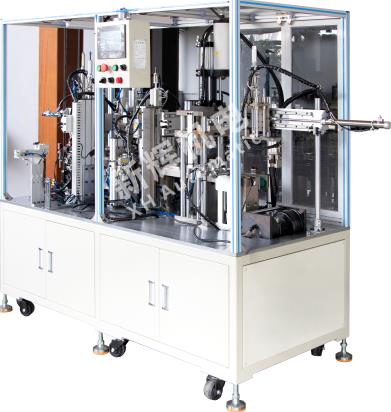What are the common electrical faults and solutions for DC motor motor automatic carbon brush cover assembly machine?
The following are the common electrical faults and solutions of DC motor motor automatic carbon brush cover assembly machine:
1, power failure
Failure phenomenon: the machine can not start, running suddenly stop or intermittent power failure.
Possible causes and solutions:
Power input problem: check whether the power plug is plugged in tightly, whether the socket is normal power supply, you can try to replace the socket or use a multimeter to measure the socket voltage is normal. If the power cord is found to be damaged, replace the power cord in time.
Power switch failure: The power switch may be damaged, resulting in the inability to connect or disconnect the power supply normally. Use a multimeter to check the switch on and off, and replace the power switch if it is damaged.
Fuse is blown: check whether the fuse is blown, if so, you need to find the cause of the fuse, such as whether there is a short circuit and other faults, troubleshooting the replacement of the same specifications of the fuse.

2, motor failure
Failure phenomenon: the motor does not rotate, abnormal speed, rotation noise or overheating.
Possible causes and solutions:
Motor winding short-circuit or disconnection: use a multimeter to measure the resistance of the motor winding, if the resistance value is abnormal, the winding may be short-circuit or disconnection. For short-circuit winding, you need to find the short-circuit point and repair or replace the motor; for broken winding, if the broken point is outside the motor, you can try to reconnect it, if it is inside the motor, you need to replace the motor.
Worn motor bearings: Worn motor bearings can cause the motor to rotate inflexibly, noisily or overheat. Check the wear of the bearings and replace them in time if they are badly worn.
Motor overload: check whether the load carried by the motor is too heavy, if the load is too heavy, reduce the load appropriately or replace the motor with a higher power.
3、Sensor failure
Failure phenomenon: The sensor of the assembling machine can not detect the position and status of the parts properly, resulting in errors or failure of the assembly process.
Possible causes and solutions:
Sensor damage: the sensor may be damaged during long-term use, such as photoelectric sensor light-emitting diode or photosensitive element damage. Use professional testing equipment or replacement method to check whether the sensor is damaged, if damaged, then replace the sensor.
Sensor position shift: During the operation of the equipment, the position of the sensor may shift, resulting in inaccurate detection. Readjust the position of the sensor to ensure that it can accurately detect the target part.
Sensor line failure: check whether the sensor connection line is loose, broken or short-circuited, if there is a problem, reconnect or replace the line.
4, controller failure
Failure phenomenon: the control program of the assembling machine can not run normally, there are error prompts, crash or can not be assembled in accordance with the preset program.
Possible causes and solutions:
Control program error: check the control program whether there are loopholes or errors, if so, update or repair the control program in a timely manner.
Controller Hardware Failure: The hardware of the controller such as CPU, memory, input/output interface, etc. may be faulty. Use professional testing equipment to check the controller hardware, if hardware failure is found, timely replacement of faulty parts or the entire controller.
Electromagnetic interference: The electromagnetic environment around the device may cause interference to the controller, resulting in controller failure. Take shielding measures, such as the use of shielded wire, shielding cover, etc., to reduce electromagnetic interference.
5, line connection failure
Failure phenomenon: The wires and cables inside the device are connected loosely, disconnected or short-circuited, resulting in some of the functions fail or the device can not operate normally.
Possible causes and solutions:
Loose connection: the equipment will generate vibration during operation, which may lead to loose wires and cable connections. Regularly check the line connections inside the equipment and tighten the loose joints in time.
Line disconnection: The line may be disconnected after long-term use, such as internal disconnection of wires, poor contact at the joints, etc. Use a multimeter to check the line through the break, for the broken line, find the broken point and reconnect or replace the line.
Line short circuit: line insulation damage, water, etc. may lead to line short circuit. Check the insulation of the line, find the short-circuit point and repair the insulation, if the short-circuit is serious, then replace the line.
※ If the above ways and means still can not solve the equipment failure, please contact Xinhui mechanical and electrical equipment through the page chat tool to seek help.







